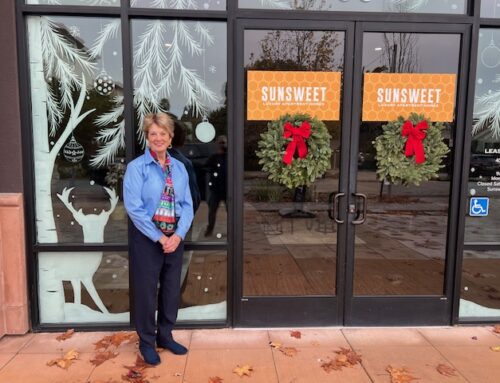Published in the December 23, 2015 – January 5, 2016 issue of Morgan Hill Life
By Cindy Adam

Lori McIntosh (celebrating her birthday), Bill Corneth, Cindy Groce Adams and Jane Lawrence Silvetti, at a restaurant in Vienna on their recent trip.
Most of us love our California wines. We will maybe venture out to try an Oregon Pinot Noir or a Washington State Syrah, but, when it comes to the cradle of winemaking — Europe — most of us will shy away. Between the labeling rules (just what is a “White Burgundy” anyway?) and the different winemaking style, we’ll just stick with our Napa Chardonnay, thank you.
However, you’re missing out on a whole new world of wines by sticking with what you know best. There are a few main differences in the style of European wines (“Old World”), versus wines made in the U.S., Australia, New Zealand or South Africa (“New World”).
One of the main differences is that, overall, Old World wines tend to have less alcohol (you can drink more!). Europeans tend to think that New World wines contain too much alcohol, which prevents them from pairing well with food. This is another major difference between Old World and New World wines. In the Old World, wine is thought of much like a food, as part of your meal and is consumed to enhance that meal. In the New World, wine is looked upon as somewhat of a “cocktail,” rather than an integral part of a meal.
In addition to containing less alcohol, Old World wines tend to be earthier and more acidic (again, a good compliment for food), whereas New World wines veer toward more fruit and more oak.
Knowing this, Old World wines are very easy to drink, especially for those who prefer little or no oak, and a lighter style in general.
So, say you decide to go into a wine store and purchase an Old World wine. Since you like Chardonnay, that’s what you’re in the market for. You search and search the white wines for a bottle that says “Chardonnay,” but you don’t see one. You know they make Chardonnays in Europe, but where are they? This is where Old World and New World really collide. In the Old World wines are labeled, not by the varietal (type of grape) it’s made from but rather, where it comes from. This necessitates some research on the part of the wine drinker to determine what type of wine you want.
For example, there is a region in France called Burgundy.
Because of their location, soil conditions, rainfall, etc., they grow both Chardonnay and Pinot Noir very well, so those are largely the two wines they produce. But, instead of labeling the wine “Chardonnay,” it will say “White Burgundy” on the label. The Pinot Noir will say “Red Burgundy.” Who knew, many years ago, that the generic “Burgundy” that we all saw on menus should have been referring to a lovely, earthy Pinot Noir!
Other interesting things about Old World wine labeling — Chianti is actually a blend of grapes, with the most prominent being Sangiovese. Champagne can only be called that if it is made in the Champagne region of France.
In fact, even if it’s made in France but not in the Champagne region, it can’t be called by that name. French sparkling wine made outside of Champagne is called Cremant. Likewise, sparkling wine in Italy is called Prosecco, in Spain it’s known as Cava, and in Germany they call it Sekt.
So be adventurous. Step outside of your New World comfort zone and try some wonderful Old World wines!
You might want to enlist the help of a knowledgeable wine person at a reputable wine store, or just strike out on your own and see where your sense of adventure and taste buds take you. Cheers!
Cindy Adams, CS, CSW, is the director of retail operations at Guglielmo Winery.







